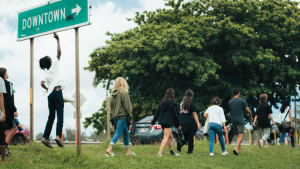The students helped create an environmentally themed mural which is permanently installed inside MEGA Lab.
Students ages 11–14 used art to unleash their scientific curiosity about the ocean through a program co-hosted by a University of Hawaiʻi at Hilo marine science laboratory.
The week-long summer camp, Youth Artivists Hawaiʻi (YAH), was co-hosted by the UH Hilo Multiscale Environmental Graphical Analysis Laboratory, commonly called MEGA Lab, which specializes in coral reef research. The lab located inside the Mokupāpapa Discovery Center at Hilo Bayfront is run by founder John Burns, an associate professor of marine science and expert on coral health, disease and ecosystems.

“Science is really a multidimensional process, and sadly, we often lose the connection to artistic creativity,” said Burns. “The Youth Artivists Hawaiʻi camp is a great way to engage a diverse audience and showcase how art and science can intersect to promote positive stewardship of our natural resources. The kids were amazing and even hosted a raging rock concert to celebrate the end of the camp.”
The summer camp shifted what is commonly called STEM activity—science, technology, engineering and math—to include art, creating a STEAM educational program. The goal of the camp was to empower young people through bridging art and science, encouraging them to think creatively about solutions for a healthy and sustainable ocean.
Touch, see, feel

Participants in the summer program learned about ocean issues, marine conservation, and coral reef protection through art-making, hands-on activities, and field trips to Hilo Bay.
Hawaiʻi Island surfer Crispin Nakoa, an alumnus of UH Hilo’s marine science baccalaureate program and tropical conservation biology and environmental science graduate program, co-managed YAH and worked firsthand with the kids on expressing complex ideas through art. Nakoa, a surfing scientist, is featured in MEGA Lab’s film about this summer’s program and outlines the importance of educating keiki early on about their island home.
“Hilo is one of the best places to have access to all these different resources. When I was a kid, I just thought that this place was awesome and nothing was ever going to change,” Nakoa explained. “But something that was missing through all the fun times that I did have, was really an understanding of all the things that put those places that I love at risk. I think it would have been helpful to learn more about that at a young age.”
A highlight for the students was working alongside Cinzah Merkins, a professional muralist from New Zealand, to create an environmentally-themed mural which is permanently housed inside MEGA Lab.
The mural project was part of the PangeaSeed Foundation’s flagship program Sea Wall: Artists for Oceans. Since its inception in 2014, the program has produced more than 450 murals in 18 countries.
For more go to UH Hilo Stories.
By—Susan Enright

